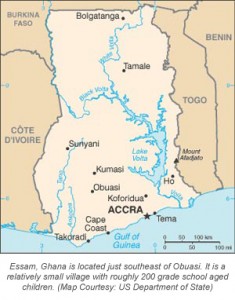The one thing we know about kids in general is that they have a lot of energy. Sometimes it’s hard for parents and teachers to keep up with them. The idea of recess is to let kids burn off some of that energy by having fun with their friends before heading back to class. But what if we could harvest energy from those kids and use it for the betterment of their community? Researchers at Brigham Young University have been working on a project to do just that.
Working in tandem with Empower Playgrounds, five engineering students from BYU embarked on Essam, Ghana to build generators into playground equipment to help light classrooms in an area where they have no electricity. The initial playground fixture was a merry-go-round built with a small generator typically used in wind turbines. When the kids turn the merry-go-round, the energy is stored for later use in the classroom. An initial problem with the fixture was the amount of revolutions needed to generate energy, as the generator would have required 300 revolutions per minute to do this. Obviously this would have proved very difficult and dangerous for the children, so gear boxes were installed to bring the requirement down to 12 revolutions per minute. The power is then directed to car batteries which are connected to chargers for LED lamps that can run for up to 50 hours.
Another goal of this project is to enable the local community to make this equipment on their own with resources that are readily available, such as recycled steel and Land Rover parts. Empower Playgrounds and BYU hope to expand to other power generating playground equipment like swing sets and zip lines in the future. Empower Playgrounds is also actively involved in classroom education, creating science kits to get kids interested in technology through fun interactive lessons and experiments.
Ghana’s Ministry of Education would like to see this technology expanded throughout the country to power their 10,000 schools. Unfortunately, Ghana is a very poor country with few resources so they are largely dependent on donations from wealthy western countries like the United States and the United Kingdom. Their GDP is similar to that of the state of Utah, yet they have 20 million more people in their country. At $7,000 per unit, the goal of 10,000 merry-go-rounds will take some time to be realized.
But researchers are hopeful that people will realize how popular and beneficial these are to the country and will make private donations to speed up the proliferation of the power-generating technology. The engineers had initially designed these units with the idea that 20 kids could use them at the same time for approximately 6 hours a day. The reality is that 40 kids at a time pile on, and use it for up to 12 hours a day. In a country where toys are almost non-existent and old tires are the most popular of those available, these playgrounds give kids a chance to have a childhood the way we in the Western world do, all the while benefitting their future by providing kid-powered energy
Justin Harmon
Staff Writer



Leave a Reply